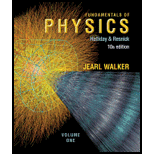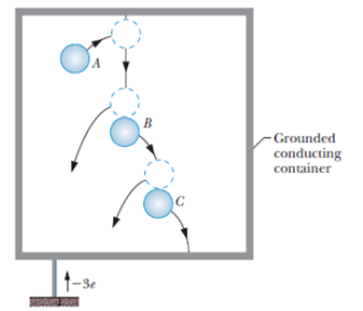
Concept explainers
Figure 21-20 shows three identical

Figure 21-20 Question 11.
Want to see the full answer?
Check out a sample textbook solution
Chapter 21 Solutions
Fundamentals of Physics, Volume 1, Chapter 1-20
Additional Science Textbook Solutions
College Physics
Matter and Interactions
Conceptual Integrated Science
Modern Physics
Lecture- Tutorials for Introductory Astronomy
College Physics: A Strategic Approach (4th Edition)
- How many electrons should be removed from an initially uncharged spherical conductor of radius 0.300 m to produce a potential of 7.50 kV at the surface?arrow_forwardA solid conducting sphere with a 11 cm radius sits inside a hollow conducting sphere with a 13 cm inside radius and a 15 cm outside radius. The gap between the conductors is filled with distilled water. If the two conductors are connected across a 12 V battery, then what is the charge on the two conductors in this configuration. The dielectric constant for distilled water is 80.arrow_forwardYou are working in a biology lab during your summer break. Your supervisor asks you to perform an experiment to find the effective spring constant (in N/m) of a partial molecule of DNA (deoxyribonucleic acid). You perform experiments and find that a single straight portion of a DNA molecule is 2.32 µm long. You then perform an activity that charges the ends of the molecule; each end becomes singly ionized: negative on one end, positive on the other. After the ends are charged, the molecule shrinks by 1.25% of its length. Use the particle in equilibrium model to balance the electric and elastic forces on a particle at one of the ends of the molecule. N/marrow_forward
- You are working in a biology lab during your summer break. Your supervisor asks you to perform an experiment to find the effective spring constant (in N/m) of a partial molecule of DNA (deoxyribonucleic acid). You perform experiments and find that a single straight portion of a DNA molecule is 2.06 µm long. You then perform an activity that charges the ends of the molecule; each end becomes singly ionized: negative on one end, positive on the other. After the ends are charged, the molecule shrinks by 1.20% of its length.arrow_forwardThe ink drops have a mass mmm = 1.00×10−11 kg each and leave the nozzle and travel horizontally toward the paper at velocity v = 15.0 m/s. The drops pass through a charging unit that gives each drop a positive charge q by causing it to lose some electrons. The drops then pass between parallel deflecting plates of length D = 2.15 cm, where there is a uniform vertical electric field with magnitude E = 7.70×104 N/C. If a drop is to be deflected a distance d = 0.340 mmmm by the time it reaches the end of the deflection plate, what magnitude of charge q must be given to the drop? Assume that the density of the ink drop is 1000 kg/m3, and ignore the effects of gravity.arrow_forwardYou are working in a biology lab during your summer break. Your supervisor asks you to perform an experiment to find the effective spring constant (in N/m) of a partial molecule of DNA (deoxyribonucleic acid). You perform experiments and find that a single straight portion of a DNA molecule is 2.06 µm long. You then perform an activity that charges the ends of the molecule; each end becomes singly ionized: negative on one end, positive on the other. After the ends are charged, the molecule shrinks by 1.20% of its length. ANSWER IN N/marrow_forward
- A molecule of DNA (deoxyribonucleic acid) is 2.17 μm long. The ends of the molecule become singly ionized: negative on one end, positive on the other. The helical molecule acts like a spring and compresses 1.00% upon becoming charged. Determine the effective spring constant of the molecule.arrow_forwardCharge of uniform density p = 62 nC/m^3 is distributed throughout a long insulating cylinder of radius R = 2 cm. Two points A and B are placed such that rA = 1 cm and rB = 3 cm from the axis of the cylinder. Determine the magnitude of the potential difference AV = VA - VB. %3D %3D AV = 0.27 V O aV = 1.5 V O AV = 0.64 V O Av = 1.1 Varrow_forwardAn electron is initially at rest on the surface of a spherical conductor with a radius of 0.01 m and a charge of 1.6 femto Coulombs. What is the initial velocity required for this electron to escape from this sphere of conduct to a point infinitely far away and have zero kinetic energy there?arrow_forward
- A lab technician wishes to model the process by which an airplane allows any charge build-up acquired in flight to leak off. She is aware that planes have needle shaped metal extensions on the wings and tail to accomplish this and that the process works, because the electric field around the needle is much larger than around the body of the plane, causing dielectric breakdown of the air and discharging the plane. Her model consists of two conducting spheres connected by a conducting wire. The sphere representing the plane has a radius of 6.00 m, the sphere representing the tip of the needle has a radius of 2.00 cm, and a total charge of 68.0 µC is placed on the combination. (a) Determine the electric potential (in V) at the surface of each sphere. V Vlarge sphere = V small sphere V (b) Determine the electric field (in V/m) at the surface of each sphere. magnitude TElarge sphere V/m = direction away from the sphere magnitude TEsmall sphere V/m direction away from the spherearrow_forwardA very long insulating cylinder of charge of radius 2.50 cm carries a uniform linear density of 15.0 nC/m. If you put one probe of a voltmeter at the surface, how far from the surface must the other probe be placed so that the voltmeter reads 175 V?arrow_forwardElectric charge can accumulate on an airplane in flight. You may have observed needle-shaped metal extensions on the wing tips and tail of an airplane. Their purpose is to allow charge to leak off before much of it accumulates. The electric field around the needle is much larger than the field around the body of the airplane and can become large enough to produce dielectric breakdown of the air, discharging the airplane. To model this process, assume that two charged spherical conductors are connected by a long conducting wire and a charge of 70.0 μC is placed on the combination. One sphere, representing the body of the airplane, has a radius of 6.00 m, and the other, representing the tip of the needle, has a radius of 2.00 cm. (a) What is the electric potential of each sphere? r = 6.00 m: V V r = 2.00 cm: (b) What is the electric field at the surface of each sphere? r = 6.00 m: V/m r = 2.00 cm: magnitude direction magnitude direction ---Select--- ---Select--- V/m O HER Carrow_forward
 Principles of Physics: A Calculus-Based TextPhysicsISBN:9781133104261Author:Raymond A. Serway, John W. JewettPublisher:Cengage Learning
Principles of Physics: A Calculus-Based TextPhysicsISBN:9781133104261Author:Raymond A. Serway, John W. JewettPublisher:Cengage Learning
